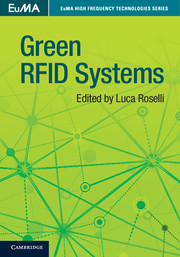Book contents
- Frontmatter
- Contents
- List of contributors
- Introduction
- 1 Context analysis
- 2 RFID background
- 3 Energy scavenging and storage for RFID systems
- 4 Technologies for RFID sensors and sensor tags
- 5 Unconventional RFID systems
- 6 Integrating tiny RFID- and NFC-based sensors with the Internet
- 7 Materials for substrates
- 8 Organic conductors and semiconductors: recent achievements and modeling
- 9 RFID enabling new solutions
- 10 Energy-efficient off-body communication using textile antennas
- Index
- References
5 - Unconventional RFID systems
Published online by Cambridge University Press: 05 October 2014
- Frontmatter
- Contents
- List of contributors
- Introduction
- 1 Context analysis
- 2 RFID background
- 3 Energy scavenging and storage for RFID systems
- 4 Technologies for RFID sensors and sensor tags
- 5 Unconventional RFID systems
- 6 Integrating tiny RFID- and NFC-based sensors with the Internet
- 7 Materials for substrates
- 8 Organic conductors and semiconductors: recent achievements and modeling
- 9 RFID enabling new solutions
- 10 Energy-efficient off-body communication using textile antennas
- Index
- References
Summary
Introduction
Non-conventional RFID systems include those that are not exclusively designed for identification purposes, but which also implement other advanced tasks such as location or sensing.
The most widespread, yet simple, RFID system is the one-bit EAS (electronic article surveillance) system whose only purpose is to detect the presence/absence of a tagged object in the vicinity of a reader. On the other hand, current state-of-the-art N-bit RFID systems serve a broader range of purposes, and the technology is experiencing tremendous advances. RFID readers are more robust, effective, and energy-efficient. Tags can now be made thinner, cheaper, often physically flexible, and more energy-efficient. Sensors, only used in wireless sensor nodes before, are currently making their way towards RFID tags. Some examples of these sensor-enabled tags can readily be found in the literature [1]. Multi-sensor tags including processing capabilities can also be found [2].
In order to be more autonomous and effective, beyond the energy harvesting subsystem, advanced tags also incorporate energy storage and power management units (Figure 5.1). Moreover, some tags integrate more than one method to harvest and store energy, as in Figure 5.1.
As the complexity of passive tags increases (due to sensor, analog-to-digital data conversion, and processing needs) the energy demand also increases, and consequently the system coverage range and the overall energy efficiency become a major concern. Some interesting approaches have been proposed, among them the use of specific signal shapes to improve the RF-DC efficiency of the harvester receivers. One of these examples unconventionally uses multi-sine signals with high PAPR (peak to average power ratio) waveforms (Figure 5.2) that benefit the rectification process on the harvester side [3]. Other kinds of power optimized waveforms, such as chaotic signals, are now being used to improve the RF-DC conversion efficiency [4].
- Type
- Chapter
- Information
- Green RFID Systems , pp. 116 - 151Publisher: Cambridge University PressPrint publication year: 2014

